ISSN ONLINE(2319-8753)PRINT(2347-6710)
ISSN ONLINE(2319-8753)PRINT(2347-6710)
G.Suryadevi , D.Vijayakumar, R.SabariMuthuKumar, Dr. K .G. Srinivasagan
|
| Related article at Pubmed, Scholar Google |
Visit for more related articles at International Journal of Innovative Research in Science, Engineering and Technology
In recent years cloud computing is one of the emerging research area that encompasses virtualization, networking, storage, software and on-demand web services. Clients, distributed servers and datacenters are the fundamental components of cloud infrastructure. The number of users in cloud computing is growing in an exponential rate at every day. Large number of user requests tries to allocate the resources for many applications which lead to high load on cloud server. To reducing the heavy load on server, the virtual machines are allocated for resources based on priority. In this paper the distributed dynamic priority based algorithm is used for balancing the load on instances effectively and to improve the system consistency, minimum response time and increase the throughput. Allocating the resources on virtual machines based on priority achieves the better response time and processing time. Load balancing ensures all instances in a node in the networks do the equal amount of work at any instant of time. Priority based resource provision to improve the utilization of resources and reducing response time of cloud services
Keywords |
| Cloud computing, Resource allocation, Priority based Scheduling, Load balancing. |
INTRODUCTION |
| Cloud computing [1], a relatively new technology, has been gaining immense popularity over the last few years where user can rent software, hardware, infrastructure and computational recourse as per user basis. The number of cloud users has been growing exponentially and apparently scheduling of virtual machines in the cloud becomes an important issue to analyze. Users can submit their jobs into cloud for computational processing or leave their data in cloud for storage. Different users have different Quality of Service requirement. Cloud scheduler must be able to schedule the tasks such a way that cloud provider can gain maximum benefit for his service and QoS requirement of userâÃâ¬ÃŸs job is also satisfied. |
| The cloud has three service models. In the Software as a Service (SaaS) model, the software or the applications are hosted over the cloud and are made available to the customers based on the pay-as-per-use model. Google Apps and Salesforce are examples of this model. The Platform as a Service (PaaS) model provides a hosting environment for the clientâÃâ¬ÃŸs application. Examples for PaaS model are Google App Engine and Amazon Web Services. The Infrastructure as a Service (IaaS) model lets the client to dynamically scale up or scale down the resources like processing power, storage capacity, network bandwidth etc. Example: Amazon EC2, Eucalyptus, etc. |
| Cloud providers are able to attain the agreed Service Level Agreement (SLA), by scheduling resources in efficient manner and by deploying application on proper Virtual Machine as per SLA [2] objective. SLAs are offered by IaaS providers to express their commitment to delivery of a certain QoS. An SLA usually include availability and performance guarantees. Most IaaS providers focus their SLA terms on availability guarantees, specifying the minimum percentage of time the system will be available during a certain period. |
| Load balancing [1] problem arises in many applications and they play a special role in the operation of parallel and distributed computing systems. Load-balancing [9-11] deals with partitioning a program into smaller tasks that can be executed concurrently and mapping each of these tasks to a computational resource such a processor (e.g., in a multiprocessor system) or a computer (e.g., in a computer network). By developing strategies that can map these tasks to processors in a way that balances out the load, the total processing time will be reduced with improved processor utilization. Load balancer performance shown in Figure.1. |
 |
| Load balancing is a process of reassigning the total load to the individual nodes of the collective system to make resource utilization effective and to improve the response time of the job. Simultaneously removing a condition in which some of the nodes are over loaded while some others are idle. Load balancing algorithms can be classified in two different ways: static load balancing algorithms and dynamic load balancing algorithms. A static load balancing algorithm does not take into account the previous state or behavior of a node while distributing the load. On the other hand, a dynamic load balancing algorithm checks the previous state of a node while distributing the load. |
RELATED WORK |
| In [3] proposed Haize concept for resource allocation. Infrastructure as a Service clouds use two resource allocation policies. An Immediate allocation policy allocates the resources if available, or else the request is rejected. Best-effort policy also allocates the requested resources if available otherwise the request is placed in a FIFO queue. Haizea uses resource leases as resource allocation abstraction and allocating Virtual Machines. It is used the immediate, best effort, advanced reservation and deadline sensitive policies. This work provides a better way to support deadline sensitive leases in Haizea while minimizing the total number of leases rejected by it. The best effort policy is used for resource allocation in eucalyptus. It maximizes resource utilization and acceptance of requests compared to the existing algorithm of Haizea. |
| In [4] proposed five database allocation algorithms for distributing databases to nodes in the cloud platform. Each database node in the cloud platform often has to service multiple number of database application system. Under the resource limitations of the node, evenly distributed databases into node are an important issue needed to be addressed. The database sizes and the number of databases must be taken into account for workload balancing among database hosts. In this private cloud to consider the databases sizes and forward the request to the job scheduler. |
| In cloud computing the scheduling of virtual machine requests is an important issue. The requested tasks can be completed in a minimum time according to the user defined time. In [5] to evaluate a scheduling algorithm that is an efficient technique for scheduling virtual machines between servers. In this the scheduling technique results are compared. Comparing these techniques the priority based scheduling algorithm improves the resource utilization and reduce the waiting time. Load balancing of non preemptive independent tasks on virtual machines is an important aspect of task scheduling in clouds. Some VMs are overloaded and remaining VMs are under loaded with tasks for processing, the load has to be balanced to achieve optimal machine utilization. The honey bee behavior algorithm [6] balances the priorities of tasks on the machines in a way that the amount of waiting time of the tasks in the queue is minimal. Then there is a significant improvement in an average execution time and reduction in waiting time of tasks on queue. |
| In priority based resource allocation the resource provisioning is done by considering the SLAs and with the help of parallel processing. Considering multiple SLA parameter and resource allocation by preemption mechanism for high priority task execution can improve the resource utilization in Cloud. The algorithm [8] considered multiple SLA parameters. That is memory, network bandwidth, and required CPU time. In this the various scheduling algorithms present for scheduling virtual machines and also proposed a dynamic priority based scheduling algorithm. The purpose of this algorithm is to calculate the priorities for incoming requests during the execution time. The objective of this algorithm is to adapt to dynamically changing progress of the incoming request. |
PROPOSED SYSTEM ARCHITECTURE |
| The Resource allocation for load balancing is designed on Eucalyptus private cloud. It has the better performance for dynamic load balancing. Eucalyptus is comprised of six components: Cloud Controller, Walrus, Cluster Controller, Storage Controller, Node Controller and an optional VMware Broker Other than the VMware Broker, each component is a stand-alone web service. Cloud Controller acts as a Front- end interface for users. It knows overall status of cloud resources and controllers. Cluster Controller acts an Administers networking resources and compute nodes. |
| Walrus Controller Storage for virtual machine images to use by compute nodes. Storage Controller acts as a persistent storage device which can be mounted inside active virtual machines .Compute Nodes provides the execution environment for virtual machines in the cloud. Load Balancing is performed by Cluster Controller. It acts as the front end for a cluster within a Eucalyptus cloud and communicates with the Storage Controller and Node Controller. The CC manages instance execution and Service Level Agreements per cluster. |
| This proposed architecture consists of three modules. First module is job scheduler. The client submits their requests on server which is present in the IaaS cloud environment. When an available resource task is assigned to a cloud, first resource availability in this cloud will be checked by job scheduler. A job scheduler records the execution schedule of all resources using a slot and to check the resource availability in this cloud. |
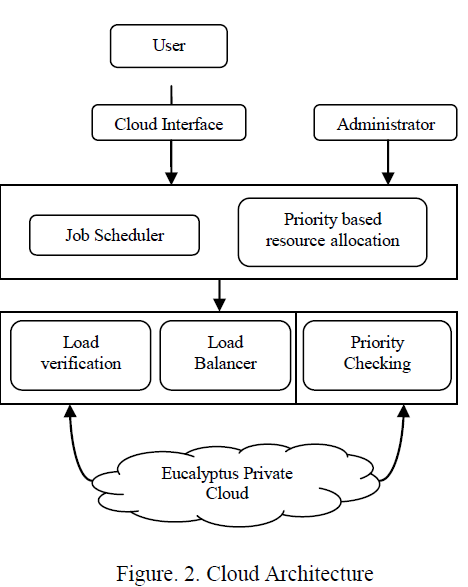 |
| Second module is resource allocation. In this module the incoming requests are directed to the virtual machines. Third module is load balancer. Load balancer will allow incoming request to be routed into servers that host the web application. |
| A. Job scheduler |
| The client submit their requests on server which is present in the IaaS cloud environment, the requests are placed in the queue and send to the server. In scheduler [15] the requests are equally distributed to the nodes. When an available resource task is assigned to a cloud, first resource availability in this cloud will be checked by the job scheduler. A job scheduler record execution schedule of all resources using a slot. The job scheduler is used to simulate from users for virtual machines. In this module we have considered a web service which has different task and this web service application are placed in the server and made the user to access these applications from the client machine |
| B. Resource allocation |
| In resource allocation we have to select the available resources depending upon the specification of our task by using load balancing condition. When the user sends the request to server, the server identifies [13] the request and redirects to the particular virtual machine. The virtual machine processes the requested task and sends the corresponding response to the client request. If any one of virtual machine have overloaded, apply load balancing policies and we can redirect the incoming request to the other virtual machines to balance the load among cloud environment. |
| C. Load balancing workflow |
| In load balancer we have created a web application in which multiple numbers of users is allowed to access the virtual machines efficiently from the client side. Initially the different users use the application and submit the task to the server. The userâÃâ¬ÃŸs requests are placed in the task queue and it is sent to the load balancer. The load balancer checks for the available virtual resources which are connected to it and it also has the status information of every virtual machine which is connected to it. The status information represents the status of every virtual machine, such as whether it is in busy state or in available state. Based on the status of virtual machines the task can be allocated to the virtual resources. For checking the availability of virtual machine we have to update the status of the virtual machine shown in Figure. 3. |
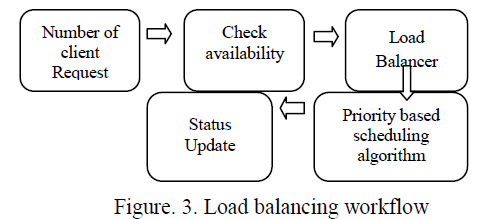 |
| The status update is represented in the form of table to represent the status of CPU speed, memory and disk of different virtual machines. The status update is used to represent the availability of the virtual machines whether it is in busy state or in the idle state so that it can be allocated for other task if it is free. The output of this load balancing workflow is to make use of available resource efficiently. When the incoming request is overloaded then the admin set the priority to each request. Multiple numbers of requests are submitted in the server and set the priority to each request. The priority is based on capacity and load factor. For using priority the client requests are redirected to the nodes. |
| D. Dynamic Priority Based Algorithm |
| A dynamic load balancing algorithm checks the previous state of a node while distributing the load. The proposed algorithm uses dynamic priority for the requests based on which the virtual machines are scheduled. It schedules the VMs to the requests depending upon their priority value, which varies dynamically based on their load factor. This dynamic priority concept leads to better utilization of the resources. Priority of a request is assigned depending upon its capacity and the load factor. |
| Algorithm: Priority (PBSA) |
| Input: N number of client Request |
| Output: Balance the Request |
| Algorithm check priority schedule |
| 1. Get the available VMList |
| //find the appropriate VMList from job scheduler |
| 2. If priority1 is not assign to request |
| 3. Priority1=max available VM |
| 4. Else if priority1 is set |
| 5. Turn ON priority1 |
| 6. Used VMList |
| 7. If VM is not used VMList then Add VM to used VMList |
| 8. Deploy request on new VM |
| 9. If priority N is not assign goto step1 |
| 10. Assign VM to ClientRequests |
| 11. If assigned the requests then return Successful |
| 12. End for |
| 13. Return available VMList |
| Priority [13] based scheduling Algorithm is intended to be used by organizations need to implement small to medium sized local clouds. This algorithm should scale to larger sized clouds because one of the main contributions of the cluster controller is load balancing compute nodes. |
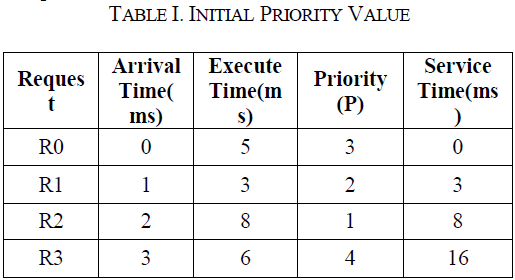 |
| Each process is assigned as a priority. Process with highest priority is to be executed first and so on. Processes with same priority are executed on first come first serve basis. Priority can be decided based on memory, time or any other resource requirement shown in Table.1. |
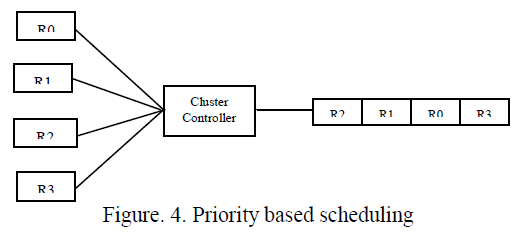 |
| The advantage of using dynamic load balancing is that if any node fails, it will not stop the progress of the system; it will only affect the system performance. When compared to a centralized environment in distributed dynamic load balanced system, the nodes can work together. However, selecting a suitable server needs real time communication with the other nodes of the network and hence, generates multiple numbers of messages in the network. Dynamic load balancer uses the load balancing policies for keeping track of updated information. |
EXPERIMENTAL RESULTS |
| A. Experiment setup |
| Eucalyptus [12] has developed an integrated solution to address the challenges of cloud configuration and management. The Eucalyptus service components make it faster and easier for users. We deploy a Eucalyptus cloud across our enterpriseâÃâ¬ÃŸs on-premise data center. Eucalyptus allows you to use our own collections of resources (hardware, storage, and network) using a self-service interface on an as-needed basis. The eucalyptus enterprise allows sensitive data to remain secure from external intrusion behind the enterprise firewall. We install Eucalyptus on the Linux distribution of Cent OS 6. The job scheduler is used to simulate requests from users for virtual machine instances. We chose a schedule that closely resembles requests for cloud resources. Jobs in this experiment come as requests from users for virtual machines. There are five different sized virtual machines and users are not limited in the size or number of instances they can request. An error is returned to the user if there is not enough space to host a requested virtual machine. When virtual image is launched, the execution resulting of running system is called an instance. An instance is a virtual machine. A virtual machine is basically an operational private computer. It contains an operating system, web applications, network accessibility, and disk drives. Eucalyptus agrees you to run instances from both Linux-based images and Windows-based images. |
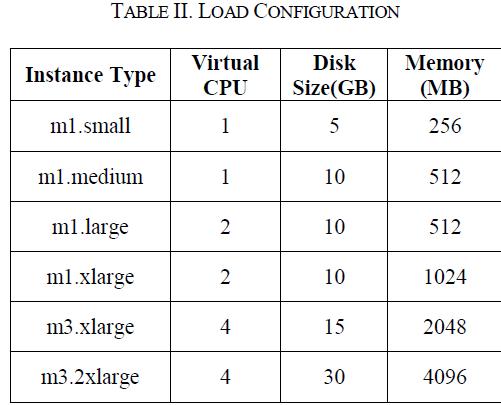 |
| The virtual machine type defines the available resources such as number of CPUs, memory size, and disk capacity. Eucalyptus has pre-defined VM types. We can change the quantity of resources associated with each of the five VM types, but cannot change the name of the VM types or the number of VM types available. If you modify the sizes they must be well-ordered. This means the CPUs, memory size and disk capacity of the next VM type must be greater than or equal to the size of the preceding VM type. |
| B. Results |
| The proposed dynamic priority based algorithm implemented like graphical representation. Java language is used for implementing load balancing on servers. Assuming the application is deployed in eucalyptus private cloud. The deployment procedures are described in the following table. |
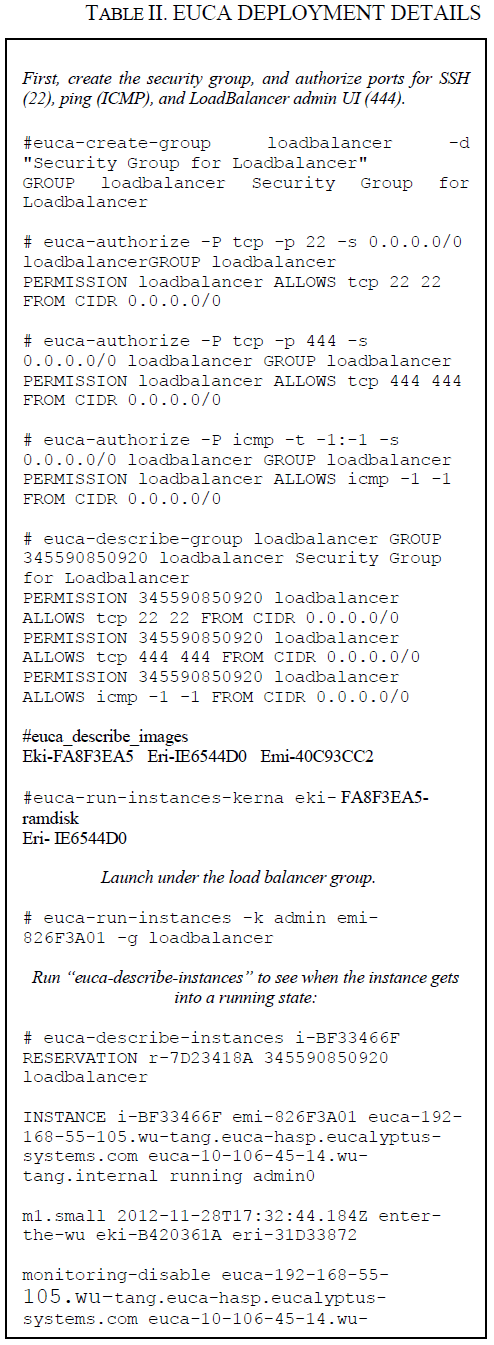 |
| Launch instances on load balancer group and run the instances. Once, the instance is up, access the Load Balancer Admin UI shown in Figure.5. |
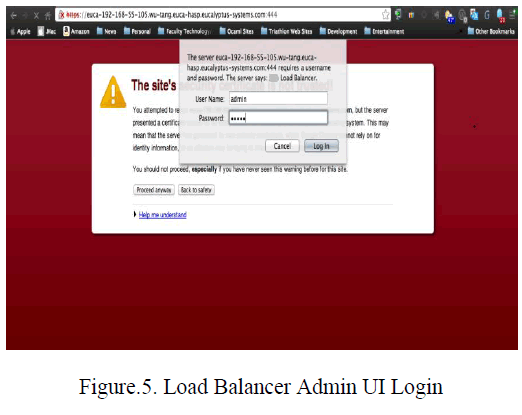 |
| In private cloud environment VM server details are monitored and the service usage of client is updated on server queue shown in Figure.6. |
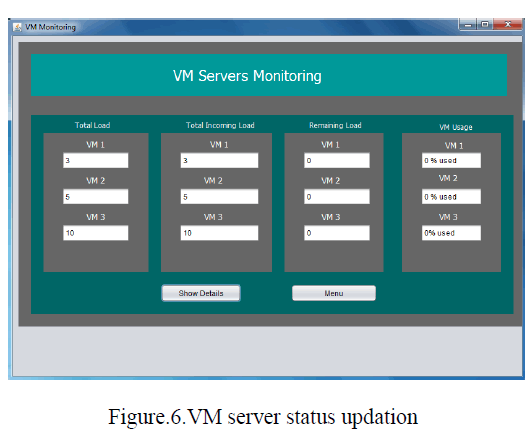 |
| The memory usage of VM server is shown in Figure.7.Using load baancer admin UI the memory usage isdescribed. In this x-axis get the resource utilization and y-axis get the number of virtua mchines. |
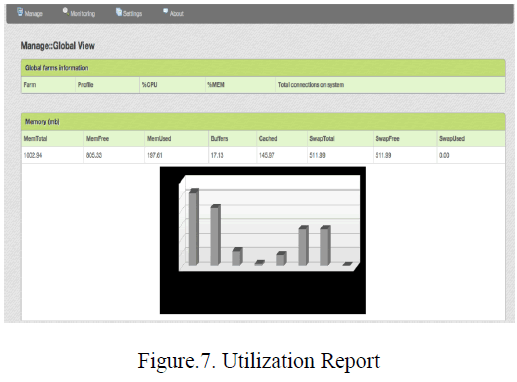 |
| The proposed dynamic priority based algorithm makes a better utilization of the available resources in cloud is shown in the Figure.8and Figure.9. |
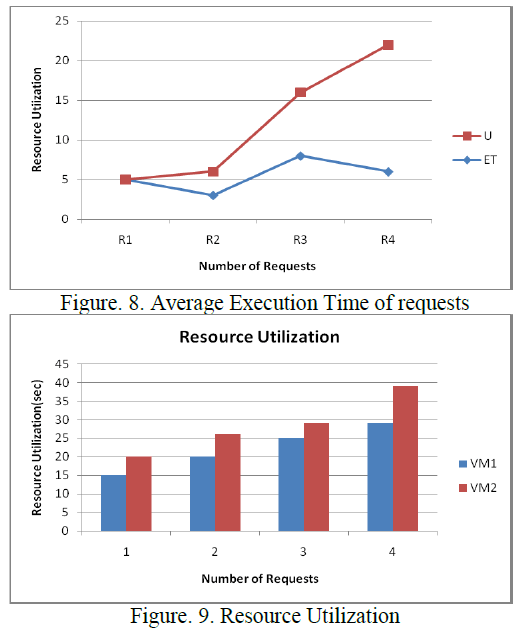 |
CONCLUSION |
| A new algorithm for the scheduling of virtual machines in Eucalyptus platform has proposed. This scheduling algorithm can be extended to suit other cloud platforms also. Here, all the incoming requests from the clients have been automatically redirected to virtual machines based on priority and also the new virtual machines are created and redirected when the requests are overloaded. The simulation result shows the better utilization of virtual machines and reduces the execution time. |
References |
|